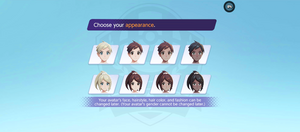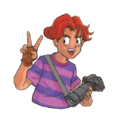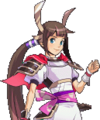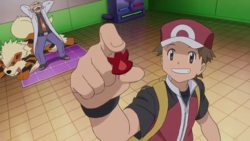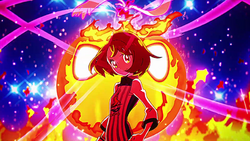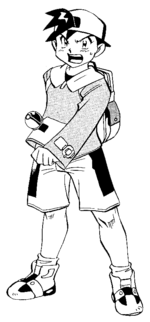Player character

|
The contents of this article have been suggested to be split into a page for the Pokémon controlled by the player (such as "Pokémon player character" or "playable Pokémon"). Please discuss it on the talk page for this article. |

|
This article is incomplete. Please feel free to edit this article to add missing information and complete it. Reason: Zany Cards and Puzzle League characters |
A player character (Japanese: 主人公 protagonist), main character,[1][2][3][4][5] protagonist[3] or previously known as a hero/heroine,[1][6][7][8] in the world of Pokémon is the central character in the plot of most Pokémon games. The player character is an avatar that represents the real player in the world of the game, and they are characterized by almost never speaking outside of occasional short dialogue options.
In the core series games
In the core series games, the player characters are Pokémon Trainers beginning their Pokémon journey. They start their journey in their hometown by getting a first partner Pokémon, a Pokémon that appears very early in their native region's Pokédex, and is usually of the Grass-, Fire-, or Water-type. The region's resident Pokémon Professor will always give them this, as well as a Pokédex. Starting in Pokémon Crystal, players can also choose their character's gender. Usually, they have rivals who begin their journey at about the same time. Players take part in several events, and meet a great number of Pokémon and people during their adventure. A common target is to conquer a Pokémon League's eight Gym Leaders and Elite Four, and become the Champion. Several additional side-quests occur during and after each game's main plot.
To date, only one player character has reappeared from an older generation in a role other than that of the player. In Generation II and the Generation IV remakes, when Ethan or Kris/Lyra travels to Mt. Silver and reaches the deepest point of the cave, Red is found, utterly silent as he was under the player's control. At the time of these games' respective releases, Red's Pikachu was the highest-leveled Pokémon owned by an in-game Trainer (Barry's fully evolved first partner Pokémon temporarily surpassed the standard set in Gold and Silver until the release of their remakes, HeartGold and SoulSilver). Red reappeared in Pokémon Black 2 and White 2 in the Champions Tournament of the Pokémon World Tournament, in the Alola-based Generation VII games as the leader of the Battle Tree with Blue, and in Pokémon: Let's Go, Pikachu! and Let's Go, Eevee! as the highest-level Trainer in the game, who presents himself to the player once they've defeated enough Master Trainers.
The player character can be named in all core series games at the beginning of the game using the same interface as that for entering nicknames for Pokémon. From Generation I through Generation V, the player name character limit was five in Japanese and Korean and seven in Western languages. From Generation VI onward, the character limit was increased to six in Japanese and Korean and 12 in Western languages.
| RGBY | FRLG | GS | C | HGSS | RS | E | ORAS | DP | Pt | BDSP | |
| Male | |||||||||||
|---|---|---|---|---|---|---|---|---|---|---|---|
| Red | Ethan | Brendan | Lucas | ||||||||
| Female | None | None | |||||||||
| Leaf | Kris | Lyra | May | Dawn | |||||||
| BW | B2W2 | XY | SM | USUM | PE | SwSh | LA | S | V | ||
| Male | |||||||||||
| Hilbert | Nate | Calem | Elio | Chase | Victor | Rei | Florian | ||||
| Female | |||||||||||
| Hilda | Rosa | Serena | Selene | Elaine | Gloria | Akari | Juliana | ||||
Pokémon as player characters
Main gameplay
In certain circumstances, the player is able to travel the overworld by controlling a Pokémon.
In all games up to Generation VI, as well as in Pokémon Brilliant Diamond and Shining Pearl, the player travels on water by using Surf.
In Pokémon Sun, Moon, Ultra Sun, and Ultra Moon, there are several Ride Pokémon. In Pokémon Legends: Arceus, there are other Ride Pokémon as well.
In Pokémon: Let's Go, Pikachu! and Let's Go, Eevee!, it is necessary to play as the Partner PikachuP or EeveeE for a short time. This is done in order to enter the vents and walk over the walls at the Team Rocket Hideout for the purpose of obtaining the Lift Key.
In Pokémon Scarlet and Violet, the player rides on Koraidon/Miraidon to travel around the Paldea region. In The Indigo Disk expansion, they can also use Synclaire's Synchro Machine to travel across the Terarium from a Pokémon's perspective.
Minigames
In Pokémon Yellow, the player controls the first partner Pokémon Pikachu in the Pikachu's Beach minigame.
In Pokémon FireRed, LeafGreen, and Emerald, the player is able to control certain Pokémon in the minigames Pokémon Jump and Dodrio Berry Picking.
In Pokémon HeartGold and SoulSilver, the player controls Pokémon in the Pokéathlon events.
In the side series games

|
This section is incomplete. Please feel free to edit this section to add missing information and complete it. Reason: Battle Revolution |
Stadium series
Three unnamed player characters appear in Pokémon Stadium series. Japanese-only Pokémon Stadium featured one male character, whose design was likely based on Red. However, for the sequel, a brand new male character was created. This player was also in Pokémon Stadium 2, where he was given a female counterpart. She appears when a player uses a Pokémon Crystal Game Pak. Like the core series player characters, these three characters remain silent throughout the games.
Additionally, the Pokémon Stadium series includes various minigames featuring Pokémon as player characters. For instance Pikachu or Voltorb are the player characters in "Thundering Dynamo" from Pokémon Stadium, while Cleffa and Igglybuff are the player characters in "Streaming Stampede" from Pokémon Stadium 2.
Orre games
Aside from the standard that many of the games' player characters take in their journey, there are also several other ways in which other player characters complete their journey, such as Wes and Michael in Pokémon Colosseum and Pokémon XD: Gale of Darkness who are called to defeat Cipher and free all of their snagged Pokémon from their Shadow state.
Gallery
| Stadium (Japanese) | Stadium (International) & Stadium 2 | Stadium 2 | Colosseum | XD | Battle Revolution | |

|

|

|

|

|

|

|
| Male | Female | Wes | Michael | Nate | Cyndy | |
In the spin-off games
Mobile
Pokémon GO
In Pokémon GO, the player character can be chosen and customized at the beginning of the game. They can also be customized at any time from the profile screen starting in version 0.31.0.
The default male player character originally wore a gray weave hat, no glasses, a shirt that came with fingerless gloves, a green and red backpack, red and black pants and leggings, and green shoes. After an update the overhaled the trainer's wardrobe, the default male player character wears a gray trainer visor, no glasses, a light blue classic hoodie, a yellow trainer backpack, yellow fingerless gloves, trainer shorts, gray leggings, and yellow running shoes. Both designs feature the character with brunette hair, teal eyes, and light skin.
The default female player character originally wore a white and red cap, no glasses, a maroon shirt that came with a choker and gloves of the same color, a red backpack, an orange ball buckle belt, gray and black pants, and orange shoes. After an update that overhaled the trainer's wardrobe, the default female player character wears a black ball cap, no glasses, a black ribbon choker, a crimson classic longsleeve, a teal urban pack, black fingerless gloves, crimson ball buckle, crimson sprint suit, black long leg warmers, and red running shoes. Both designs feature the character with brunette hair, teal eyes, and light skin.
Pokémon Masters EX
In Pokémon Masters EX, the player character, Scottie or Bettie, is a Pokémon Trainer who travels to the artificial island of Pasio to participate in the Pokémon Masters League tournament.
All player characters (with the exception of Florian and Juliana from Pokémon Scarlet and Violet) appear as playable characters. So far, Red, Ethan, Brendan, Dawn, Hilbert, Rosa, Serena, Gloria, and Rei are confirmed to be based on the player character of their respective games. The other player characters are based on the non-player characters as applicable. Red is the only character based on a core series player character to be a Champion, as it is unconfirmed if any of the other characters based on the player characters have won their respective region's Pokémon League.
Pokémon: Magikarp Jump
In Pokémon: Magikarp Jump, the player plays as a person of ambiguous gender always referred to as "you", who fishes and trains Magikarp to jump as high as possible.
Game Boy Color
Pokémon Trading Card Game series
In Pokémon Trading Card Game and Pokémon Trading Card Game 2: The Invasion of Team GR!, Mark and Mint do not use actual Pokémon themselves, but cards instead.
Pokémon Puzzle Challenge
In the Challenge mode of Pokémon Puzzle Challenge, the player character is Ethan. In this mode, he challenges the Gym Leaders and the Elite Four of Johto, as well as some other characters, in puzzle games.
Game Boy Advance
e-Reader games
There are several player characters in the e-Reader games.
Pokémon player characters:
- Aipom (Harvest Time)
- Butterfree (Flower Power)
- Cleffa (Ride the Tuft)
- Corsola (Diving Corsola)
- Ditto (Ditto Leapfrog)
- Doduo (Jumping Doduo)
- Drowzee (Dream Eater)
- Farfetch'd (Leek Game)
- Hoothoot (Follow Hoothoot)
- Kingler (Kingler's Day)
- Machop (Machop At Work)
- Pichu (Hold Down Hoppip)
- Two Pichu (Tokotoko Truck)
- Pikachu (Pika Pop)
- Poliwrath (GO, Poliwrath!)
- Rapidash (Fire Hoops)
- Sudowoodo (Sneak and Snatch)
- Totodile (Big Fruit Strategy!)
- Tyranitar (Mighty Tyranitar)
- Tyrogue (Punching Bags)
- Ursaring (Berry Tree)
- Voltorb (Rolling Voltorb)
- Wobbuffet (Watch Out!)
- Wooper (Wooper's Juggling Game)
- Zubat (Night Flight)
Human player characters:
- Imakuni? (Imakuni?'s Ball)
- Several player characters (Construction: Action)
Nintendo DS
Pokémon Conquest
In Pokémon Conquest, the player character is the Warlord of Ransei's kingdom of Aurora. Their objective is to unite the seventeen kingdoms of the region, stop Nobunaga, and meet the legendary Pokémon that created Ransei. As more stories are unlocked, more characters become playable.
Pokémon Ranger series
In the Pokémon Ranger series, Lunick, Solana, Kellyn, Kate, Ben and Summer are not Pokémon Trainers, but instead Pokémon Rangers. They use the Pokémon they have captured with the Capture Styler to help them along the way. They also have partner Pokémon that follow them wherever they go.
Pokémon Trozei
In Pokémon Trozei!, the main protagonist is Lucy Fleetfoot, who must release all the Pokémon stolen by Phobos Battalion.
Pokémon Dash
In Pokémon Dash, the player character is Pikachu.
Learn with Pokémon: Typing Adventure
In Learn with Pokémon: Typing Adventure, the player can choose from four preset outfits, two for each gender, at the beginning of the game.
Nintendo 3DS
Pokémon Art Academy
The player is a student at the Pokémon Art Academy. The player's appearance is not seen in-game, although they are identified by their name and gender (male or female). The player's ID card also displays their student level and signature.
A non-player character of the opposite gender often interacts with the player as a friendly classmate: either Lee or Lily.
Pokémon Shuffle
In Pokémon Shuffle the unseen player character goes on a Pokémon journey. They are initially assisted by Amelia, a journalist who leaves to write a report on this journey. The player captures many Pokémon, and battles other Trainers they meet. The first of those Trainers taught them how to Mega Evolve Pokémon.
Nintendo 64
Pokémon Snap
In Pokémon Snap, Todd Snap must strive for something different from Trainers. He must capture all the Pokémon on Pokémon Island—on film.
Hey You, Pikachu!
- Main article: Player (Hey You, Pikachu!)
In Hey You, Pikachu!, the player uses the PokéHelper to talk to Pikachu. The player is shown as a silhouette.
Pokémon Puzzle League
Pokémon Puzzle League is an anime-based game. The player characters come from the anime, instead of their core series counterparts. In the 1P Stadium mode, the player character is Ash Ketchum. In the 2P Stadium mode, there are 15 player characters to choose: Ash Ketchum, Gary Oak, the Team Rocket trio, Tracey, Ritchie, Brock, Misty, Lt. Surge, Erika, Koga, Sabrina, Blaine, Giovanni, Lorelei, and Bruno.
Wii
PokéPark series
In PokéPark Wii: Pikachu's Adventure, the player character is a Pikachu. In PokéPark 2: Wonders Beyond, the player characters are Pikachu, Snivy, Tepig, and Oshawott.
Nintendo Switch
Pokémon Quest
- Main article: Player (Quest)
In Pokémon Quest, the player takes a boat to Tumblecube Island, aiming to acquire the precious loot hidden on the island with the help of their drone MoBee and a number of Pokémon they befriend along the way.
This player is never seen within the game, though they are a human. Unlike most player characters in the Pokémon franchise, they have a defined personality and set lines of dialogue.
Pokémon UNITE
In Pokémon UNITE, the player is a Trainer who became interested in Unite Battles and went to Aeos Island to participate. Professor Phorus and Erbie welcomed them, and Erbie taught the player the rules of Unite Battles. Phorus allows them to use a energy rewards system that converts Aeos energy into items.
Pokémon UNITE has intricate customization features. However, all players start off wearing the Orange Unite Set, with one of eight default appearances.
Arcade
Pokémon Battrio
- Main article: Avatar (Battrio)
Players with Memory Keys have the ability to create an avatar (Japanese: アバター) that will serve as their profile for all activity while playing Pokémon Battrio. Players can select either a male or female avatar of varying types, and give their profile a nickname of up to four characters.
Pokémon Ga-Olé
In Pokémon Ga-Olé, the main protagonist can be played in the arcade game as either a male or a female.
Pokémon Mezastar
In Pokémon Mezastar, players pick a male or female avatar and can unlock customization parts from winning battles with special trainers or through events.
Pokkén Tournament
In Pokkén Tournament, the player took control of a character who wishes to rise to the top of the Ferrum League. The player avatar can be customized at the beginning of the game, with more customization options available to purchase in the shop as the game progresses.
Pokémon Tug of War Tournament
In Pokémon Tug of War Tournament: Absolutely Get Medal!, the player characters available for this tug-of-war game are: Ash's Pikachu, Iris's Axew, Cilan's Pansage, Ash's Tepig, Ash's Snivy, and Ash's Oshawott.
Windows
Pokémon Play It! series
In Pokémon Play It! and Pokémon Play It! Version 2, Julie talks directly with the player. In the introduction of both games, Julie says that she and the player are Pokémon Trainers. However, they play the Trading Card Game rather than train Pokémon.
Perdue series
In Pokémon Team Rocket Blast Off, Pokémon Poké Ball Launcher, and Pokémon Seek & Find, the player characters are Ash Ketchum and May.
Pokémon Team Turbo
In Pokémon Team Turbo, there are 20 racers available: Bulbasaur, Venusaur, Charmander, Charmeleon, Squirtle, Blastoise, Pikachu, Treecko, Torchic, Blaziken, Mudkip, Skitty, Plusle, Spheal, Metagross, Kyogre, Groudon, Rayquaza, Deoxys, and Munchlax.
Sega consoles

|
This section is incomplete. Please feel free to edit this section to add missing information and complete it. Reason: Add the player characters from more Pico games |
Sega Pico games
In Pokémon: Catch the Numbers!, there are several minigames with different player characters: Ash, Nurse Joy's Chansey, Jigglypuff (recurring anime character), or Ash's Pikachu.
Advanced Pico Beena games
In Pokémon Advanced Generation: Pokémon Number Battle!, Ash and May are the player characters in different game modes.
Various
Pokémon Rumble series
In Pokémon Rumble, the player starts as a Toy Rattata. In Pokémon Rumble Blast, the player starts as a Toy Pikachu. In Pokémon Rumble World, the player starts as their Mii character.
Pokémon Mystery Dungeon series
In the Pokémon Mystery Dungeon series, players play as actual Pokémon. Unlike most other Pokémon games, the player actually talks, but is given preset responses to say to questions. In Red Rescue Team, Blue Rescue Team, Explorers of Time, Explorers of Darkness, and Explorers of Sky, after defeating the final boss, the player speaks in full sentences instead of silently thinking to themselves or having answer choices. This type of dialogue is used by the player on rare occasions, in small amounts, throughout the story of Gates to Infinity.
Available player characters:
- All 386 Pokémon up to Generation III in Pokémon Mystery Dungeon: Red Rescue Team, Blue Rescue Team, and Rescue Team DX.
- Plus, in Rescue Team DX, evolutions that were added in later generations are now available. For example, Sylveon.
- 491 Pokémon up to Generation IV (Shaymin and Arceus are unavailable) in Pokémon Mystery Dungeon: Explorers of Time and Explorers of Darkness.
- 492 Pokémon up to Generation IV (Arceus is unavailable) in Pokémon Mystery Dungeon: Explorers of Sky, as well as in Pokémon Mystery Dungeon: Keep Going! Blazing Adventure Squad, Let's Go! Stormy Adventure Squad, and Go For It! Light Adventure Squad.
- 144 Pokémon up to Generation V in Pokémon Mystery Dungeon: Gates to Infinity.
- 720 Pokémon up to Generation VI (Volcanion is unavailable) in Pokémon Super Mystery Dungeon.
For the starting player character and their partner, see hero Pokémon and partner Pokémon.
Super Smash Bros. series
The Super Smash Bros. series of fighting games includes characters from multiple franchises other than Pokémon. The playable characters from the Pokémon franchise found in Smash Bros. games are: Pikachu, Jigglypuff, Pichu, Mewtwo, Lucario, Squirtle, Ivysaur, Charizard, Greninja, and Incineroar. In Super Smash Bros. Brawl and Super Smash Bros. Ultimate, Squirtle, Ivysaur and Charizard are playable under the control of the Pokémon Trainer, who is based on the player character versions of Red and Leaf and represents the concept of player characters in the Pokémon games.
Detective Pikachu series
In Detective Pikachu, the protagonist is Tim Goodman, who teams up with Detective Pikachu to solve several mysteries and search for his missing father. In Detective Pikachu Returns, Tim returns as the protagonist, but there are a few occasions over the course of the story where the player can control Detective Pikachu directly. There are also occasions where the player can control another Pokémon that Detective Pikachu is riding on: Growlithe, Galarian Darmanitan, Luxray, or Pangoro. In addition, during a certain part of the story, the player assumes control of Harry Goodman.
Gallery

|
This section is incomplete. Please feel free to edit this section to add missing information and complete it. Reason: Missing images of the player characters from Mezastar and UNITE |
Pokémon Arcade Games
| Battrio | ||||
| Male | ||||
| Hot Blooded Type | Cool Type | Glasses Type | Naughty Type | Fashionable Type |
| Female | ||||
| Hot Blooded Type | Cool Type | Glasses Type | Naughty Type | Fashionable Type |
| Ga-Olé | Mezastar | |||
| Male | Female | Male | Female | |

|

| |||
Super Smash Bros. series
| Super Smash Bros. series | |||||

|
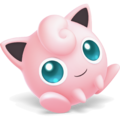
|

|
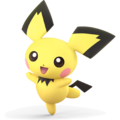
|

|

|
| Pikachu | Jigglypuff | Mewtwo | Pichu | Pokémon Trainer | |

|
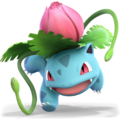
|

|
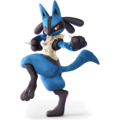
|

|
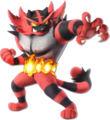
|
| Squirtle | Ivysaur | Charizard | Lucario | Greninja | Incineroar |
Pokémon characters
| Dash | Rumble | Rumble Blast | Pikachu's Adventure & Wonders Beyond |
Wonders Beyond | ||

|
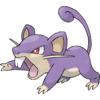
|

|

|

|

|

|
| Pikachu | Rattata | Pikachu | Pikachu | Snivy | Tepig | Oshawott |
Stadium minigames
| Stadium | |||||
| Clefairy Says | Dig! Dig! Dig! | Ekans' Hoop Hurl | Magikarp's Splash | Rock Harden | |

|

|

|

|

|
|
| Clefairy | Sandshrew | Ekans | Magikarp | Metapod | Kakuna |
| Run, Rattata, Run | Snore War | Sushi-Go-Round | Thundering Dynamo | ||

|

|

|

|

| |
| Rattata | Drowzee | Lickitung | Pikachu | Voltorb | |
| Stadium 2 | |||||
| Barrier Ball | Clear Cut Challenge | Delibird's Delivery | Eager Eevee | ||

|

|

|

|

|

|
| Mr. Mime | Scyther | Pinsir | Scizor | Delibird | Eevee |
| Egg Emergency | Furret's Frolic | Gutsy Golbat | Pichu's Power Plant | ||

|

|

|

|

| |
| Chansey | Furret | Girafarig | Golbat | Pichu | Pikachu |
| Rampage Rollout | Streaming Stampede | Topsy-Turvy | Tumbling Togepi | ||

|

|

|

|

|

|
| Donphan | Cleffa | Igglybuff | Hitmontop | Togepi | Omanyte |
Pokémon Team Turbo

|

|

|

|

|
| Bulbasaur | Venusaur | Charmander | Charmeleon | Squirtle |

|

|

|

|

|
| Blastoise | Pikachu | Treecko | Torchic | Blaziken |

|

|

|

|

|
| Mudkip | Skitty | Plusle | Spheal | Metagross |

|

|

|

|

|
| Kyogre | Groudon | Rayquaza | Deoxys | Munchlax |
In the anime
Main series
In the Pokémon anime, six of the player characters have been given major roles, four of them in the main series. Ash Ketchum represents Red (his game counterpart), being based on him in appearance as well as basic history (Ritchie, by extension of resembling Ash, also resembles Red, although his basic history is unknown).
At the beginning of Pokémon the Series: Ruby and Sapphire, May was introduced in order to better represent Generation III, as both Misty and Brock are characters who originated in Generation I. Likewise, at the beginning of Pokémon the Series: Diamond and Pearl, Dawn joined Ash to represent Generation IV. In Pokémon the Series: XY, Serena joined Ash in order to represent Generation VI.
Jimmy and Marina appeared in The Legend of Thunder! special, taking a similar role to Ash and his companions, fighting Team Rocket members to protect Legendary Pokémon. While the protagonists of Generation II did not join Ash's company, these two filled the roles as the anime counterparts to Ethan and Kris.
Lyra appeared in An Egg Scramble!, and joined the group for a brief time until Bagged Then Tagged!.
Ash and his friends have also encountered several player characters from the side games. Todd Snap was the first, and a special case, as he originated in the anime before appearing in Pokémon Snap. He joins the group for a few episodes at two points in the original series: once during the Kanto journey and once during the Johto journey. The others, Solana, Kellyn, and Ben are all Pokémon Rangers that Ash and friends assisted in rescuing and protecting Pokémon.
So far, Brendan has only made a few select cameo appearances at the beginning of some of the movies, while Lucas made a cameo at the beginning of Giratina and the Sky Warrior, where he was battling Brendan. Ethan also appears with a second counterpart at the beginning of Zoroark: Master of Illusions. Much later, Rei made a cameo at the end of The Arceus Chronicles (Part 4).
None of the Generation V, Generation VII, or Generation VIII player characters have yet been seen in the main anime.
Pokémon Black 2 and White 2 Animated Trailer
Nate and Rosa both appeared in the animated trailer for Pokémon Black and White Versions 2.
Pokémon Origins
Red has a direct counterpart as the main character in Pokémon Origins.
Pokémon Omega Ruby and Alpha Sapphire Animated Trailer
Brendan and May both appeared in the animated trailer for Pokémon Omega Ruby and Alpha Sapphire.
Pokémon Generations
Direct counterparts of Red, Ethan, Brendan, Hilbert, and Calem appeared in Pokémon Generations.
Much like Red, none of the other player characters depicted in the miniseries have any lines of dialogue.
Pokémon Masters Animated Trailer
Scottie, Rosa, Bettie, Red, and Brendan appeared in the animated trailer for Pokémon Masters.
Pokémon: Twilight Wings
Direct counterparts of Victor and Gloria appear briefly in Pokémon: Twilight Wings.
GOTCHA!
All playable characters from Pokémon Red and Blue to Pokémon Sword and Shield, with the exception of Kris, Leaf, Chase, and Elaine appear in the music video, GOTCHA!.
POKÉTOONs
Red appears in The Pancham Who Wants to Be a Hero of POKÉTOON.
Pokémon Evolutions
Direct counterparts of Victor, Selene, Calem, Serena, Hilda, Lucas, May, Ethan, Red, and Elaine appeared in Pokémon Evolutions. With the exception of Serena, they are all based on the player character of their respective games.
This was the first time that a player character appeared with a customized playable skin color outside the games, with Victor and Elaine appearing with darker skin.
Pokémon: Paldean Winds
A direct counterpart of either Florian or Juliana appears briefly appear briefly in Pokémon: Paldean Winds.
Biri-Biri
Anna is the direct counterpart of Juliana, who appeared in the music video, Biri-Biri.
In the manga
Pokémon Adventures
Pokémon Adventures features cross-canon counterparts for almost all of the player characters in the core series games, who are usually named after one of the games they originate from. Red is based on his game counterpart, while Green is based on the unnamed female character who appears in Pokémon Red and Green's official strategy guide. After Leaf was introduced in Pokémon FireRed and LeafGreen, Green changed into Leaf's clothes to serve as her counterpart. Gold is based on the then-unnamed player character Ethan. Once Pokémon Crystal was released and introduced a female player character, Kris, Crystal was introduced to be her counterpart. Additionally, though Lyra is usually accepted as a different character from Kris, Crystal has appeared wearing Lyra's clothes to serve as her counterpart, rather than introducing a second Johto female protagonist for the HeartGold & SoulSilver arc.
Since having both a male and female player character became a staple for the series from then on, most player characters have been adapted into Pokédex holders who are named after the first two paired games in a generation, with the male player character being named after the first game of the pair and the female player character being named after the second game of the pair. For example, Ruby is a counterpart to Brendan and Sapphire is a counterpart to May, the protagonists of Pokémon Ruby and Sapphire. The one exception to this is Lucas and Dawn, the player characters of the Sinnoh-based games. Diamond is a counterpart to Lucas, but the name Pearl was given to Barry's counterpart. Dawn's counterpart goes deliberately unnamed for the first few volumes of the Diamond & Pearl arc, only being revealed in Startling Staraptor to be Platinum, after the name of the third version was known to the public. Additionally, despite not being introduced in the first paired games of a generation, Nate and Rosa received counterparts in the form of Blake and Whitley, respectively.
This pattern was broken in the Scarlet & Violet arc. Florian's counterpart was named Violet, being named after the second paired game, while Juliana's counterpart was named Scarlet, being named after the first paired game.
A few player characters from spin-off games have appeared in Pokémon Adventures as well. Todd Snap appears as a supporting protagonist in the Emerald arc, though he is never referred to by name. Lunick and Solana star in the side story manga Pokémon Ranger the Comic: Double Mission, while Kellyn and Kate star in its sequel, Pokémon Ranger: The Comic – Shadows of Almia.
Pokémon Pocket Monsters
Pokémon Pocket Monsters features cross-canon counterparts for some of the player characters from the core series games. However these characters usually have minor appearance in the manga, with the main focus of the series being on Red, who is based on his game counterpart from Pokémon Red and Green. Humorously during Pokémon Ruby-Sapphire, Red meets a different Red who is based on his game counterpart from Pokémon FireRed and LeafGreen. This Red is depicted as a better Trainer than the main Red. Similar to Pokémon Adventures, most player characters are named after one of the games they originate from, such as Ethan's counterpart being named Gold. This is not always applied as Leaf's counterpart is named Blue, however her Japanese name is みどり (Midori), a feminine name that means "green", likely a reference to the title of Pokémon LeafGreen, one of the games she originated from.
While Ruby and Sapphire are named similarly to their Pokémon Adventures counterparts, their Japanese names are reversed, with May's counterpart instead being named after the first paired game, while Brendan's counterpart is named after the second paired game.
Pokémon Zensho
Satoshi is the direct counterpart of Red in Pokémon Zensho.
Pokémon Gold & Silver: The Golden Boys
Gold and Chris are the direct counterparts of Ethan and Kris in Pokémon Gold & Silver: The Golden Boys. Red counterpart was also mentioned in the manga.
Pokémon Ruby & Sapphire (CoroCoro Comic)
Ruby and Sapphire are the direct counterparts of Brendan and May in Pokémon Ruby & Sapphire (CoroCoro Comic). While sharing the names with their Pokémon Adventures's counterparts, they also share their first partner Pokémon.
Pokémon Ruby & Sapphire Special Walkthrough Comic!
Brendan and May have direct counterparts in Pokémon Ruby & Sapphire Special Walkthrough Comic!.
Pokémon Battle Frontier
Rald is the direct counterpart of Brendan in Pokémon Battle Frontier.
Pokémon Diamond and Pearl Adventure!
Hareta and Mitsumi are the direct counterparts of Lucas and Dawn in Pokémon Diamond and Pearl Adventure!.
Pokémon Diamond and Pearl (manga)
Kenta is the direct counterpart of Lucas in Pokémon Diamond and Pearl (manga), while Dawn's counterpart shares the same name with her game counterpart.
Pocket Monsters Diamond and Pearl: Regigigas Major Capture Operation!!
Kaito and Yuki are the direct counterparts of Lucas and Dawn in Pocket Monsters Diamond and Pearl: Regigigas Major Capture Operation!!.
Pocket Monsters HGSS Jō's Big Adventure
Jō is the direct counterpart of Ethan in Pocket Monsters HGSS Jō's Big Adventure, while Red's counterpart shares the same name with his game counterpart.
Pocket Monsters HeartGold & SoulSilver Go! Go! Pokéathlon
Takashi is the direct counterpart of Ethan in Pocket Monsters HeartGold & SoulSilver Go! Go! Pokéathlon, while Lyra's counterpart shares the same name with her game counterpart.
Pokémon HeartGold SoulSilver: Pokédex Completion Comic
Soul is the direct counterpart of Ethan in Pokémon HeartGold SoulSilver: Pokédex Completion Comic, with Lyra's counterpart going unnamed.
Be the Best! Pokémon B+W
Monta is the direct counterpart of Hilbert in Be the Best! Pokémon B+W.
Pocket Monsters BW
Shin is the direct counterpart of Hilbert in Pocket Monsters BW: The Heroes of Fire and Thunder. In the sequel, Pocket Monsters B2 W2 ~ A New Legend ~, Arata is introduced as the direct counterpart of Nate.
Pocket Monsters BW: Good Partners
Hilbert and Hilda's counterparts make a cameo in Pocket Monsters BW: Good Partners.
Pocket Monsters BW: Meetings with the Legends
Touya is the direct counterpart of Hilbert in Pocket Monsters BW: Meetings with the Legends.
Pokémon Omega Ruby Crimson Passion and Pokémon Alpha Sapphire Indigo Wisdom
Omega and Alpha are the direct counterpart of Brendan in Pokémon Omega Ruby Crimson Passion and Pokémon Alpha Sapphire Indigo Wisdom. Unlike in other manga, Brendan has two direct counterparts.
Pokémon Horizon
Akira and Mana are lose counterparts of Elio and Selene in Pokémon Horizon.
Pocket Monsters Let's Go! Pikachu Let's Go! Eievui Adventure Start Comic
Hajime is the direct counterpart of Chase in Pocket Monsters Let's Go! Pikachu Let's Go! Eievui Adventure Start Comic
Trivia
- According to the May 2010 volume of CoroCoro Comics and Ken Sugimori in the January 2011 volume of Nintendo Dream, the player characters of Pokémon Black and White, Hilbert and Hilda, were deliberately made to be older than the player characters of previous games.[9]
- According to game scenario author Toshinobu Matsumiya, Hilda and Hilbert were initially visualized to be at the age of 16.[10]
- Most of the male characters that Ash, the main character from the Pokémon anime, has encountered have been from side games, like Pokémon Ranger. The only counterpart of a male player character from the core series games who has met Ash is Ethan, in the thirteenth movie.
- Red's dialogue during his appearance as an NPC reflects the games' player characters' status as silent protagonists.
- The list of default names per gender generally repeats from game to game, starting in Pokémon Crystal. Exceptions to this are character-specific names, which are names unique to a character and are usually references to the title or aspects of the game.
- Until Generation V, the given Japanese names of the male player characters in the core series games (as NPCs) all ended in ki (キ). This excludes Red's appearance in Generations II and IV, as he is not a player character during the games when he is an NPC. Inclusively, Lunick's Japanese name also ends in ki.
- Despite female player characters not being introduced until the second generation, there are more female player characters than male player characters (due to both Kris and Lyra existing for the Johto region).
References
- ↑ 1.0 1.1 Pokémon Omega Ruby and Alpha Sapphire official website (archive) "Choose Your Hero! Introducing the main characters you may choose between to experience your adventure in the Hoenn region!"
- ↑ Pokémon Sword and Shield official website
- ↑ 3.0 3.1 Pokémon Legends: Arceus official website: "The Main Character and Akari or Rei [...] As the protagonist of the Pokémon Legends: Arceus game, you’ll join the Galaxy Team as a member of the Survey Corps."
- ↑ Pokémon Scarlet and Violet official website: "As one of the main characters, you’ll set off on your adventure. Your outfit will vary depending on whether you play Pokémon Scarlet or Pokémon Violet. Who knows what kind of story awaits you?"
- ↑ Pokémon Masters EX gives all characters based on player characters the "main character" theme skill.
- ↑ Pokémon X and Y official site (archive) "In addition to playing as a human hero, you'll meet many other folks."
- ↑ Pokémon Sun and Moon official website (archived) "You will choose to be a hero or heroine in Pokémon Sun and Pokémon Moon, and you can name yourself whatever you'd like."
- ↑ Pokémon Ultra Sun and Ultra Moon official site "While he’s the boss of Team Rocket, he was also the Gym Leader of the Viridian City Gym, and he stood in the hero’s way countless times."
- ↑ Nintendo Dream volume 201 (translation)
- ↑ Twitter | マツミや @matsumiyan
| Player characters | ||||||
|---|---|---|---|---|---|---|
| ||||||

|
This game character article is part of Project CharacterDex, a Bulbapedia project that aims to write comprehensive articles on each character found in the Pokémon games. |


































